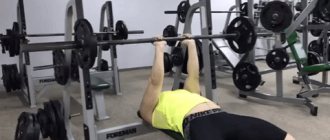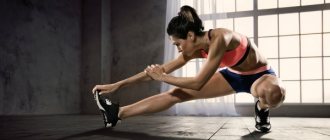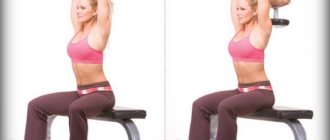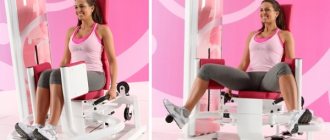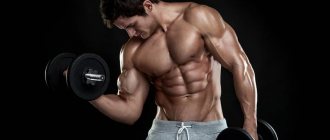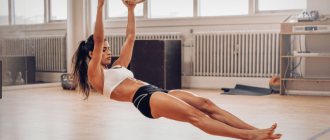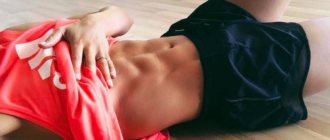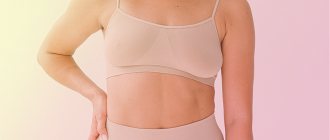Exercises for triceps and chest muscles are performed using special sports equipment, or the athlete uses his own body weight to create a force load. Training to develop these areas of muscle is recommended for girls who want to have a toned, sculpted and aesthetically attractive figure, want to lose excess weight or increase physical strength in their arms.
Rules and features
Exercises to build chest and triceps muscles are performed in the gym under the guidance of a fitness instructor, or complex training is carried out independently at home.
Chest and triceps exercise
At all stages of the training process, it is necessary to observe the following rules and features of pumping these muscle sections:
- provide the body with plenty of fluids during physical exercise, as well as within 2 hours after completing the workout to fully restore the water balance in muscle tissue and internal organs;
- Before starting classes, always do a quality warm-up of the whole body, the duration of which should be at least 10-15 minutes. (this will minimize the risk of injury);
- use a variety of sports equipment that create different levels of physical stress on the same muscle groups (for example, perform training with a barbell, dumbbells, kettlebells);
- use working weights of training equipment that do not create a critical load on the muscles of the arms and chest, but ensure its uniform pumping until the effect of pleasant fatigue is achieved;
- the average duration of strength training should not exceed 60 minutes;
- to build muscle mass, it is necessary to select heavy weights, at which the maximum number of repetitions of the physical exercise will be 5-6 times in 3 approaches;
- within 1 hour after completing the workout, it is necessary to eat food that is rich in proteins and carbohydrates (during this period of time, the athlete’s body is in dire need of the nutrients necessary to build muscle tissue);
- girls who want to achieve the effect of relief of the triceps and chest muscles should use light weights with a large number of repetitions (for example, sports equipment is lifted 15-20 times in 3-4 approaches to dry out the muscles);
- exercises with sports equipment must be alternated with activities during which one’s own body weight is used;
- training the chest muscles using a bench press should be carried out under the supervision of an instructor or another athlete;
- throughout the entire period of playing sports to build up the muscles of the chest and triceps, the girl should provide her body with a complete and balanced diet;
- warm-up and the main set of physical exercises should be performed in sports shoes and the most comfortable clothing;
- It should be remembered that muscle development occurs during a period of complete rest, as well as a regular supply of nutrients (in this regard, at least 1-2 days should pass between repeated training).
Muscle arrangement diagram
Exercises for the chest and triceps can be performed using dumbbells, barbells, or using parallel bars, gymnastic rings, and a horizontal bar. Training to develop these areas of the body is carried out in the gym, at home, or in the fresh air, which is most beneficial for the cardiovascular system.
Strength training for chest and triceps
In the presented program, strength exercises for the chest and strength exercises for the triceps alternate with each other for an even and high-quality workout of each muscle group. The training process will consist of three rounds - supersets. Each superset includes two exercises. The exercises alternate with each other and are repeated in 4 approaches. The training below is suitable for both beginners and experienced athletes (the level of load is regulated by the weight of the dumbbells).
The superset technique involves sequentially performing these exercises without rest or with a short rest of 10-20 seconds. Between supersets, rest for 2-4 minutes (with a small or medium weight of dumbbells, 2 minutes is enough, with a large weight of dumbbells, it is fashionable to rest for 4 minutes).
Important: be sure to warm up before work. Perform arm rotations, lateral extensions, and stretch the wrist joint. This will allow you to prepare more thoroughly for the upcoming work. Be sure to look at the finished warm-up before training for the chest and triceps.
First superset
Alternate these two exercises with minimal rest between sets (up to 20 seconds). There should be a total of 4 approaches for each exercise (you can do 3 approaches if the workout is short, or 5 approaches if your dumbbell weight is light). Each exercise is performed for 10-12 repetitions (push-ups can be increased to 15-17 repetitions per set).
Pushups
Benefit of the exercise : This is a starting element of training, which is effective in developing the volume and strength of the pectoralis major muscles, as well as arm extensors. In addition, the process involves the front bundle of deltas, which is responsible for the visual width of the shoulders. In addition, this is one of the most accessible exercises, because it does not require additional equipment.
How to do it : Taking a prone position, spread your arms slightly wider than the line of your collarbones. Try to keep your elbows pressed closer to the sides of your body. Next, lower yourself, stopping your chest a couple of centimeters from the floor (you don’t need to lie down completely). After this, push off with force, focusing the load on the chest area.
We recommend reading: How to strengthen the transverse abdominis muscle
In the process of performing approaches, you can change the load in the direction of complication or simplification. For example, if it becomes difficult for you to do push-ups from the floor, switch to a lighter version - push-ups from a bench:
If, on the contrary, you want to increase the load level, go to push-ups with your feet on a bench:
Dumbbell extension from behind the head
Benefit of the exercise : This is an isolating element for developing strength, volume and relief of the triceps. If you work with an increased amplitude, bending and extending the arm as much as possible, the exercise becomes one of the best for pumping the lateral head. Additionally, the long and medial heads of muscles are involved.
How to do it : Sitting on a bench, take the apparatus in your hands, then grab the dumbbell with your palms by the top plate and lift it above you. Fully extend your arms, then begin to slowly lower the weight behind your head. When your arms form right angles at the elbows, begin to forcefully push the weight, focusing the tension in the triceps.
Rest 2-4 minutes before the second superset.
Second superset
Alternate these two exercises with minimal rest between sets (up to 20 seconds). There should be a total of 4 approaches for each exercise (you can do 3 approaches if the workout is short, or 5 approaches if your dumbbell weight is light). Each exercise is performed for 10-12 repetitions.
Dumbbell press
Benefits of the exercise : Training the chest and triceps is never complete without pressing exercises. This element is similar to the barbell press, but its main benefit is to develop the athlete’s balancing abilities. Due to this, the muscles are pumped more symmetrically than with a barbell press, where one side can dominate the work.
We recommend reading: Hatha yoga - strength fitness training to reunite mind and body
How to do it : The work is done while lying on a special bench. Initially, the weight can be placed on the chest, and then rotate the dumbbells into a longitudinal grip, as if holding a bar. Make sure that your forearms are always perpendicular to the floor surface. Next, squeeze the weight in front of you, trying to keep the projectiles in one line without distortion.
Bent over arm extension
Benefits of the exercise : This is another strength exercise for the triceps, allowing you to use three of its heads at once. The element also strengthens the static strength of the lumbar muscles and helps in the formation of correct and beautiful posture. You can work with both hands, or with each in turn (depending on personal preference).
How to do it : Stand up straight, first holding dumbbells in your hands. Next, bend your arms so that a right angle is formed at the elbow (while holding the weight). Lean your body forward, maintaining the natural arch of your back, and lock the position. After this, perform arm curls, focusing the tension in the triceps.
Before the third superset, rest for 2-4 minutes.
Third superset
Alternate these two exercises with minimal rest between sets (up to 20 seconds). There should be a total of 4 approaches for each exercise (you can do 3 approaches if the workout is short, or 5 approaches if your dumbbell weight is light). Each exercise is performed for 10-12 repetitions.
Dumbbell flyes
Benefits of the exercise : Strength exercise on the chest specifically creates beautiful volume and relief of the corresponding muscle group. It kind of isolates the muscles, since you can't rely on inertia or cheating in the process. For this element, it is better to use light or medium weights in order to reduce the overall risk of injury.
Calculate your ideal sports weight!
How to do it : Lying on your back, lift the weight in front of you with your arms slightly bent at the elbows. Fix them, then slowly move the weight to the sides, achieving a feeling of stretching in the pectoral muscles. There is no need to lower the dumbbells too low to reduce the risk of injury from the exercise. When you feel the stretch, bring your arms back.
Reverse push-ups
Benefit of the exercise : An ideal exercise for working the triceps muscle without the use of additional sports equipment. When working, you use your own body weight. The chest and triceps training element is optimal for beginner athletes or at home if it is not possible to do classic push-ups on uneven bars.
How to do it : Sitting on a bench, rest your palms on its surface, then move your pelvis forward, supporting your torso with the strength of your arms. Place your feet on your heels, first stretching them out. Now slowly lower yourself until your hips are 5-10 centimeters from the floor surface. Afterwards, rise back up, relying solely on the strength of your triceps.
With the exercises presented, you can perform a classic chest and triceps workout without supersets. To do this, do sequential chest exercises first, then triceps exercises.
Check out our ready-made workout plans for men:
Check out our ready-made workout plans for women:
Why are they needed?
Regularly performing a set of exercises to develop the triceps and chest muscles allows you to achieve the following quality results:
- get rid of excess fat deposits in the area of the outer arms;
- tighten breast tissue;
- reduce total body weight;
- prevent the appearance of sagging and sagging breasts;
- increase physical strength in your hands;
- make your figure slimmer and more attractive.
During physical exercises, the muscles of the chest and triceps create an indirect load on other parts of the musculoskeletal system. In the process of doing push-ups on the uneven bars, the girl simultaneously trains the muscles of the back, lower abs, trapezius and the entire shoulder girdle.
A similar effect is observed when performing other types of exercises that are designed to pump up the chest and triceps.
Contraindications and possible harm
Chest and triceps muscle training is contraindicated for girls and women of all age groups who have the following health problems:
- phlebeurysm;
- thrombophlebitis;
- hematological diseases associated with an increased risk of blood clots or internal bleeding;
- ulcerative damage to the walls of the stomach and duodenal mucosa;
- previous myocardial infarction or cerebral stroke;
- severe traumatic brain injuries, the consequences of which are impaired coordination of movements, epileptic attacks, frequent dizziness, loss of consciousness;
- diabetes;
- exhaustion of the body caused by concomitant diseases of the gastrointestinal tract, prolonged fasting, abuse of dietary norms;
- disturbance of water-electrolytic balance;
- the period of recovery of the body after surgical operations;
- intervertebral hernia and other pathologies of the spinal column, in which training with the use of heavy sports equipment is contraindicated;
- arterial hypertension or hypotension;
- all types of heart diseases associated with heart rhythm disturbances (additional physical activity will lead to an exacerbation of these diseases);
- the presence of foci of a chronic or acute infectious process that causes a decrease in the body’s immune status (ARVI, influenza, chronic tonsillitis);
- inflammatory and degenerative pathologies of bones and joints.
Chest and triceps exercises are contraindicated for girls who are pregnant or lactating a newborn baby.
During this period, the woman’s body should receive moderate physical activity in the form of leisurely walks in the fresh air. Training to pump up the muscles of the chest and triceps should be carried out with extreme caution for girls who have once suffered clavicle fractures, injuries to the upper limbs and chest.
Main complex
There are a huge number of physical exercises aimed at developing the muscle tissue of the chest and triceps.
Pushups
This type of training allows you to simultaneously pump the entire front of the chest and triceps.
To perform this exercise, you must follow the following algorithm:
- Fix the palms of your hands and toes of your feet on the floor surface.
- Keep your back and buttocks as level as possible.
- As you inhale, bend your elbows, lowering your chest towards the floor.
- As you exhale, straighten your upper limbs, rising to the starting position.
At the initial stages of training, girls need to do 5-7 push-ups from the floor in 3 sets. As your physical strength increases, the number of repetitions gradually increases.
Pull the dumbbells back
Dumbbell kickbacks are an isolated exercise that exclusively targets the triceps without engaging the chest muscles.
The training goes as follows:
- Place your feet shoulder-width apart.
- Take dumbbells in your hands.
- Bend forward.
- Keep your back as straight as possible.
- As you inhale, straighten your elbow joint and move the dumbbells back by tensing the muscles in the back of your arm.
- As you exhale, return the upper limbs to their original position.
This exercise is performed simultaneously on both hands, or alternately on the left and right limbs. To achieve a positive result during one workout, it is enough to do 7-10 repetitions in 3-4 approaches. The weight of dumbbells is selected taking into account the physical capabilities of each girl.
Pull-up on the horizontal bar
Performing pull-ups on the horizontal bar allows you to develop the muscles of the upper chest. The advantage of using this training is that it can be carried out in a room in a residential building, apartment, or go to the sports field.
To perform this exercise, you must follow the following algorithm:
- Fix your hands on the crossbar.
- Relax your body.
- As you inhale, bend your elbows, straining the muscles of your back, chest and abs.
- Reach your chin towards the bar of the horizontal bar.
- As you exhale, return the body to its original position.
Pull-ups on the horizontal bar allow you to develop the muscles of the upper chest, and also minimize the risk of back injury. For a girl who is just starting to play sports, during one workout it is enough to perform 5 repetitions in 3 sets.
Lifting the body on parallel bars
The use of gymnastic bars allows you to develop triceps muscle tissue using your own body weight.
To do this, it is enough to follow the following rules:
- Fix the palms of the upper limbs on the handles of the gymnastic bars.
- Keep your arms straight.
- While inhaling, bend the elbow joints of the upper limbs, lowering the entire body weight down towards the handles of the parallel bars.
- As you exhale, straighten your elbows, moving your body up.
While performing this exercise, the girl must ensure that her back remains straight at all times. To achieve a positive training result, it is recommended to do 7 sit-ups on parallel bars in 3 sets.
Dumbbell flyes from a lying position
This exercise is performed in a sports hall. To carry out the workout, you will need 2 dumbbells with the same weight and a bench press.
This exercise looks like this:
- You need to lie down on a bench press bench.
- Take dumbbells in your hands.
- As you inhale, bend your elbows, lowering the sports equipment down towards the chest while simultaneously moving it to the sides.
- As you exhale, lift the dumbbells up again.
This is a complex exercise that simultaneously develops the entire front part of the chest and also pumps up the triceps. Dumbbell raises from a lying position are performed in 10-12 repetitions of 3-4 sets. The weight of sports equipment is selected individually.
Lifting the barbell up with a narrow grip
To perform this exercise you will need a barbell with a curved bar.
This training for the chest and triceps muscles is carried out in compliance with the following algorithm of actions:
- Place your feet shoulder-width apart.
- Take a barbell with a W-shaped bar in your hands.
- At the grip site, place the upper limbs as close to each other as possible.
- Bring the barbell to chest level.
- As you inhale, slowly lift the sports equipment up above your head, straightening your arms at the elbows.
- As you exhale, lower your upper limbs down, returning the bar to chest level.
In the process of performing this exercise, accentuated physical activity is provided on the triceps. The upper part of the chest muscles, as well as the muscles of the shoulder girdle, are indirectly pumped.
Bench press
Chest and triceps exercises develop muscle definition and physical strength. The bench press allows you to pump several muscle groups at once.
This training looks like this:
- The girl lies down on a bench to press a barbell from a lying position.
- The hands are fixed with a regular grip on the surface of the bar of the sports equipment.
- As you inhale, the arms bend at the elbow joints, and the barbell lowers towards the chest.
- As you exhale, the sports equipment rises up again.
At the initial stages of training, it is recommended to use barbells with a weight of 10-20 kg. During one session, you must perform 10 repetitions in 3 sets. This exercise simultaneously develops the chest muscles and triceps.
Triceps push-ups from a bench
During this exercise, an isolated load is placed on the triceps. The advantage of this training is that it does not require special gym conditions. It is enough to have a spacious room containing a chair, bed or bench.
Triceps push-ups are performed as follows:
- It is necessary to turn your back to the bench, chair, bed.
- The palms of the hands are located on the surface of the above objects.
- The legs are straightened and stretched forward so that only the heels are in contact with the floor.
- As you inhale, your arms bend at the elbows and your body slowly lowers down.
- As you exhale, the girl straightens her arms, lifting the entire weight of her body with her triceps.
This exercise is performed in 10-12 repetitions in 3 sets. During training, it is necessary to ensure that the thoracic spine remains as straight as possible. Before starting the lesson, it is necessary to conduct a high-quality warm-up of the shoulder girdle.
Throwing the bar in front of you
Exercises for the chest and triceps are performed 2-3 times a week with breaks of 24-48 hours between each session. The front bar throw is a versatile workout that helps develop the chest and back arm muscles.
This exercise looks like this:
- The girl picks up a barbell with a mass of 10-15 kg.
- Feet become shoulder-width apart.
- The bar of the bar rises to chest level.
- As you inhale, the sports equipment is sharply pushed forward.
- As you exhale, press the barbell against your chest with your hands again.
The above actions are performed at maximum speed. The advantage of this exercise is that in addition to developing the muscles of the chest and triceps, it also trains the shoulder girdle. During one lesson, you need to do 15 repetitions in 3-4 approaches.
Dmitry Dragun
Training split in the off-season Split 4+1
Mon. Legs W. Chest, middle delta Avg. Back, rear deltoid, trapezius Thu. Biceps, triceps Pt. Rest And again 4 days of training.
All pressing exercises were performed with an emphasis on the negative phase, rest between approaches was 1–1.5 minutes.
Legs
1. Hip extension in the simulator: 4×15; 2. Barbell squats (Smith front squats): 4×10–12; 3. Squats with narrow legs in the Hackenschmidt machine: 3×15; 4. Lunges with a barbell (3×15) on each leg; 5. Hip flexion in the simulator: 4×15; 6. Deadlift on straight legs (bending over with a barbell): 4×12; 7. Standing calf raises, bent over (“donkey”): 3×15–25; 8. Platform toe press: 3×8–12.
Chest, middle delta
1. Barbell (dumbbell) press lying on a horizontal bench, negative: 4×4–6; 2. Incline dumbbell press, negative: 4×4–6; 3. Wide-grip parallel bars with weight: 3×10–12; 4. Dumbbell flyes lying on a horizontal (incline) bench: 3×15; 5. “Pullover” with a dumbbell: 3×15;
6. Barbell overhead press while standing (sitting): 4×10; 7. Standing dumbbell lateral raises: 7×20-15-12-10-12-15-20; 8. Barbell row to the chin with a wide grip: 3×12.
Back, rear deltoid, trapezius
1. Wide grip pull-ups: 4×12; 2. Block row to the chest with a narrow grip: 3×12; 3. Barbell row to the waist with a reverse grip: 4×12; 4. Block row to the waist while sitting: 3×12; 5. T-bar row (deadlift): 3×12; 6. One-arm dumbbell row: 3×12; 7. Bent-over dumbbell flyes: 4×12; 8. Reverse extensions to the rear beam (in the “butterfly”): 3×15; 9. Shrugs with dumbbells (with barbell): 4×8–12.
Hands. Biceps, triceps
1. Standing barbell curls, straight bar (curved bar): 4×10–12; 2. Arm extensions in a block, rope (straight grip): 4×15; 3. Arm curls while sitting on an incline bench: 4 × 10–12;
4. Close-grip bench press (narrow-grip dips with weight): 3×10–12; 5. Standing arm curls (“hammer”): 3×12; 6. French bench press with a barbell (dumbbells): 3×12.
Training split in preparation for competitions
Split 5+2
Mon. Legs (front surface of the thigh, emphasis), lower leg, abs (cardio in the evening) Tue. Chest Wed. Back, trapezius, abs (cardio in the evening) Thu. Legs (back of the thigh), deltoids, lower legs Pt. Arms, lower legs, abs (cardio in the evening) Sat. Rest Sun. Rest Cardio training 3 times a week for 30 minutes.
Exercises are added, combined into supersets, and rest between approaches - 45-60 seconds.
Legs (front surface of the thigh, accent), lower leg, abs (in the morning)
1. Hip extensor: 5×15–20; 2. Squats with a barbell 4×15–25; 3. Hack machine squats with narrow feet: 3×15; 4. Squats in the “Hack machine” facing the machine with wide feet: 3×15; 5. Standing calf raises: 5×8–12; 6. Raising the body on the “Roman chair”: 4 to failure; 7. Raising the knees to the chest while hanging on the bar: 4 to failure; In the evening, cardio 30 minutes - exercise bike.
Breast
1. Bench press (dumbbells) on an incline bench (angle 45 degrees): 4×15-15-12-10 (in the last approach, dropping the weight to failure); 2. Dips + dumbbell press on a horizontal bench: 3×15; 3. Incline dumbbell flyes: 3×20-15-12 (in the last approach, dropping the weight to failure); 4. “Pullover” with an emphasis on the pectoral muscles: 3×15–20;
5. Hand raises in “Crossover” while standing: 3x20.
Back, trapezius, abs (morning)
1. Seated overhead pull-down: 4×20-15-12-10 (drop set in the last approach); 2. Block row to the chest with a narrow grip: 3x20-15-12 (in the last approach - drop set); 3. Bent-over barbell row: 4×20-15-12-10 (drop set in the last approach); 4. Seated block row with reverse grip: 3×20-15-12 (in the last approach – drop set); 5. Bent-over dumbbell row with one hand to the waist: 3×20-15-15; 6. Deadlift: 2×20; 7. Seated dumbbell shrugs: 3×15; 8. Shrugs with a barbell behind your back in Smith: 3x15; 9. Raising and lowering legs while lying on a bench: 6 to failure; In the evening, cardio 30 minutes - treadmill.
Legs (hamstrings), deltoids, lower legs
1. Lying leg curls: 4×20-20-15-15; 2. Romanian deadlift (barbell forward bend): 4×20-15-12-10; 3. Lunges with dumbbells while walking around the hall: 3×20-15-15; 4. Hyperextension with weight: 3×20-15-15; 5. Seated dumbbell press + standing dumbbell raises to the sides: 4×15–20; 6. Bent-over dumbbell flyes to the sides + “Crossover” flyes to the sides on the back beam: 4×15–20; 7. Dumbbell rows to the chin + raising dumbbells in front of you: 3×15–20; 8. Raises on toes, standing in an inclined position (“donkey”): 4×20–25; 9. Platform toe press: 3×15–20.
Arms, lower legs, abs (morning)
1. Standing barbell curls + French barbell press: 4×15; 2. Arm curls on the “Scott Bench” + extensions in a block with a rope handle: 3×15; 3. Standing barbell curls with a reverse grip + push-ups on parallel bars with a narrow grip: 3×15; 4. Arm curls in “Crossover” while standing, to the peak of the biceps + “kickbacks” with a dumbbell: 3×15–20; 5. Seated calf raises: 5×15; 6. Crunches: 5 to failure; In the evening, cardio training for 30 minutes - exercise bike.
Dmitry Dudushkin
The split in the off-season is usually 1+1 (training day, then rest day). Training with hardware occurs every other day, but everything varies depending on how you feel. Hard days alternate with easy ones. The entire body is worked over 8 or 12 days (see explanations below).
Day one – legs (front thigh and shins) Day two – rest Day three – chest Day four – rest Day five – back thigh and back* Day six – rest Day seven – shoulders and arms** Day eight – rest Then complete repetition of the cycle .
*It is also possible to stretch the cycle on the days of the hip and back (split into two days and rest between them). **You can do this with your shoulders and arms in a similar way (shoulders – rest – arms). The workouts are not tied to the week; if the state of the body allows it or there is some kind of force majeure, then the workouts are shifted, but no more than three in a row. And no more than one force majeure event in a monthly cycle, otherwise a state of overtraining begins to accumulate. We are talking about training without pharmaceutical support for a long time! Naturally, during preparation and in the “charged” state they are different, the frequency of classes, the number of sets and repetitions, as well as working weights change, rest days are reduced, etc. In general, the schedule seems to be “compressed”.
Front thigh and lower leg***
1. Seated calf raises: 4×20–30; 2. Standing calf raises, giant set or “21” with weight release from maximum: 1-2×7-7-7; 3. Jumping on toes: 1 to the maximum and stretching after; 4. Seated leg extension: 1×30–40; 5. Strictly sequential jumping and jumping on a high step: 1 to maximum; 6. Leg press: 3x40-20-12; 7. Hack squats, imitation of squats with weight on the chest, facing the machine with support on the shoulders and elbows: 3-4 × 20-20-12-6; 8. Classic “Hack Squat”, 1 giant set based on the principle of a reverse pyramid with 3 resets. For example, from 200 kg to the maximum, from 100 kg to the maximum, from 50 kg to the maximum and with an empty trolley to the maximum! 9. Seated leg extensions: 1 giant set with a reverse pyramid reset of 3 times. The number of reps per microset is 12. Example: all tiles – 12 reps; 3/4 simulator tiles – 12; 2/4 – also for 12 repetitions; ¼ – also for 12 times.
Breast***
1. Crossover fly, lying on a horizontal bench: 4x40-20-12-8 and the last approach with a reverse pyramid with a reset; 2. Crossover fly, lying on a bench at an angle of 25–30 degrees: 3×15; 3. Dumbbell press, lying on a bench at an angle of 30 degrees and with 30% amplitude, basically - the zone of overcoming the “dead” point with the chest: 3–4 × 15–12; 4. “21” from a bench press at a 45 degree angle. Performed in 3 drops from higher to lower weights. Example: maximum weight at 6–8, reset and again at 6–8, third time at 6–8; 5. Press up while lying down at an angle of 45 degrees with a 5–10 kg pancake: 2×20–30; 6. Wiring in “Crossover”: 3×20; 7. “Pullover”, lying on a bench with an incline for the press, with a dumbbell and harnesses (in a power rack or “Smith”): 3x30–20.
Cardio for 30–40 minutes at 18 degree steps, pulse (from 136 to 155 beats) according to the Karvonen method – this is 60–75% of MHR.
***Breasts are a lagging group for me. I was torn twice, so I usually use 55–70 of the absolute maximum and train it according to the principle of priority with a very short rest.
Day of rest.
Cardio in the morning on an empty stomach for 30-40 minutes at 18 degrees, pulse (from 136 to 155 beats) according to the Karvonen method - this is 60-75% of MHR for my age!
Hind thigh and back
1. Lying leg curl: 4×20–12, pyramid; 2. Hyperextension for the lower back: 1 to the maximum (usually 25-30 repetitions); 3. Hyperextension on the back thigh, in the “Romanian” style, with a barbell: 1x20; 4. Straight leg row: 2×20; 5. One series of alternating standing leg curls (in an extension machine) to the maximum, first with the pyramid up, and then back to lower the load. On average, 25–30 repetitions in total; 6. “Pullover” block (in horizontal traction for the back): 3×40-20-10; 7. Wide-grip head pull, to the back of the head: 4×30-15-8-6; 8. Pull-ups with a medium parallel grip, the sum of all repetitions is from 30 to 50. I perform them practically without rest in a power rack with a stand so that at the end I can help with my legs. As a rule, I perform it in 2-3 stages. 9. “Hybrid” row, lying on a bench at an angle of 30 degrees, with dumbbells. It is a mix of traction and pulling: 2–3×15–12.
Cardio for 30–40 minutes at 18 degree steps, pulse (from 136 to 155 beats) according to the Karvonen method – this is 60–75% of MHR.
Day of rest.
Cardio in the morning on an empty stomach for 30-40 minutes at 18-degree increments, pulse (from 136 to 155 beats) according to the Karvonen method - this is 60-75% of MHR for my age.
Shoulders and arms
1. A series of shoulder swings on a 35-degree bench, first on the rear delts, then on the front ones, then on the middle ones, then stretching on the rear delts. Series: 3-4×30-20-15-12, between series rest no more than a minute; 2. Bench press while standing. Ripping the bar off the trapezius is like the starting position for squats! 4-5×20-15-12-8, at least 6 repetitions; 3. Shrugs with a barbell with an explosion: 4-5×20-20-15-12, at least 8 repetitions. 4. Broach in the “Smith Machine”: 3×20-15-12; 5. Bench press with medium grip on a horizontal bench: 4×20-15-12-8; 6. Arm extensions on a pulley with a rope handle: 4x40-20-12-6 and then reset back “striptease” without rest; 7. French press with a dumbbell, sitting with support on the back. I call the execution style “reverse hammer”: 1–2×30–15; 8. Bench curls on the “Scott Bench” with a barbell: 2-3x20-12-8; 9. Bending your arms on a bench 45 degrees with dumbbells with both hands at the same time: 1–2×15–12;
10. “Hammer” with dumbbells: 3x30-20-15.
Week schedule
The table below shows a weekly training schedule for developing chest and triceps muscles.
| Day of the week | Organization of the training process |
| Monday | On the first day of a weekly training course, it is recommended to perform the following exercises: l moving dumbbells back; l pull-ups on the horizontal bar; l push-ups. This training can take place both in the gym and at home. |
| Tuesday | Throughout Tuesday you must refrain from physical activity. This is a day for recovery of chest and triceps muscles after sports. It is recommended to eat protein and carbohydrate foods. Cereal porridges, chicken breasts, and rabbit meat are best suited. The body must be provided with plenty of fluids. |
| Wednesday | On Wednesday, you need to perform the following set of exercises to develop the triceps and chest muscles: l lifting the barbell with a narrow grip; l dumbbell flyes from a lying position; l push-ups on parallel bars. Before carrying out this workout, it is recommended to perform a particularly good warm-up of the back and shoulder girdle, since an indirect load will be created on these areas of the musculoskeletal system. |
| Thursday | The entire Thursday must be devoted to proper rest, quality nutrition, and also to exclude any psycho-emotional stress. On this day, your diet should include seafood, fresh vegetables and fruits for faster recovery of muscle tissue. |
| Friday | On Friday, the following exercises of the weekly complex of training for the triceps and chest muscles are performed: l bench press from a lying position; l triceps push-ups from a bench; l throwing the bar in front of you. This set of exercises is recommended to be performed in a gym, since in this case the use of special equipment will be required. |
| Saturday | On Saturday you need to take a break from physical activity that was aimed at the triceps and chest muscles. A girl should receive a balanced diet throughout the day. |
| Sunday | On the final day of a weekly training complex, you should take care of moderate stress on the cardiovascular system. This is necessary to prevent the development of cardiac diseases. On Sunday, it is recommended to perform the following types of heart and blood vessel training: l light jogging for a distance of 1.5 to 3 km, depending on individual capabilities; l cycling for a distance of 5-10 km; l swimming in the pool; l cross-country running over a distance of 2-4 km. Girls who are just learning sports aimed at actively pumping the muscles of the chest and triceps can replace intense cardiological stress with a hike in the forest. Long walking is an excellent form of exercise for the heart and blood vessels. |
All exercises in a weekly course of sports should be performed at the same time of day. This will allow the body to more quickly adapt to the established training schedule.
The occurrence of discomfort in the muscles, the appearance of a feeling of pain in the ligaments during exercise is the basis for stopping physical activity, as well as undergoing an examination. This will reduce the risk of injury. Especially when working with barbells and dumbbells.
French press
Yes, the French press can be performed without special equipment. For this we again need a chair or stool. When performing this exercise, the lateral head of the triceps takes on more of the load.
- Lie down on your back. You can lie on the floor or on the bed, so that there is space behind your head.
- Hold a chair or stool with your arms straight in front of you - grab the base of the legs.
- As you inhale, smoothly lower the projectile down behind your head, bending your elbows.
- As you exhale, return the projectile to its original position, straightening your arms at the elbow joint.
Perform 4 sets of 10-12 repetitions.
When to expect the effect
The first positive results in the physical development of the chest and triceps muscles will be noticeable no earlier than 2 months later. regular workouts.
This is provided that the girl eliminates the use of alcoholic beverages, gives up smoking, avoids stressful situations, and provides her body with balanced nutrition and proper rest in between workouts.
Exercises for the muscles of the chest and triceps contribute to the development of a slender body and allow you to get rid of excess amounts of subcutaneous fat. Training to pump up these sections of the musculoskeletal system includes regular push-ups, pull-ups on the horizontal bar, lifting the body on parallel bars, working with dumbbells and a barbell.
Physical exercises for the chest and triceps can be performed in the gym, or you can organize independent training at home.
In the latter case, it is enough to use your own body weight. Every girl who wants to develop the muscles of the chest and triceps must undergo a preliminary examination by a general practitioner for possible contraindications.
Basic triceps exercises
Bench press
Most will say that this is a basic exercise for developing the pectoral muscles, but the triceps also play a big role in it. The first half-way from the chest, the bar rises up due to the pectoral muscles, and the rest of the way until the bar is fully pressed up is due to the triceps.
The bench press develops the pectoral muscles to a greater extent, but without strong triceps, the result of the bench press itself will be sad. In other words, this is a strength exercise for the triceps, in which you can immediately see what it is capable of.
Close grip press
It works perfectly on all 3 areas of the triceps muscle, but if the development of the anterior delta band is weak, it greatly overloads it, so if the shoulder is injured, perform it very carefully.
The main thing when performing the exercise is to keep your elbows as close to your body as possible; if, when squeezing the bar up, your elbows still go to the sides, then the working weight is too heavy and the bar is being squeezed up due to the chest being involved in the work.
The bar must be lowered to the center of the chest; if higher, the wrists receive overload; if lowered to the bottom of the chest, excessive load falls on the deltoids.
Reverse push-ups
An effective exercise that can be performed both in the gym and at home. The legs must be placed on the base, and the hands on the gymnastic bench; if the legs are placed on the floor, the triceps will receive a small load and will work at half strength.
Place the gymnastic bench across the back at such a distance from the legs that when lowering the body down, it does not interfere with movement. You need to place weights on your hips (the help of a partner will not be superfluous) and lower yourself until the bend in your elbows reaches 90 C.
Performing reverse push-ups should eliminate jerking, otherwise when lowering, in addition to stretching the triceps, the front deltoids are greatly stretched; if you jerk at the beginning of the lift, you can easily injure your shoulders.
Dips
A good exercise that can be performed almost anywhere where you can find something like parallel bars. Loads all 3 heads of the triceps, subject to a number of rules:
- Straighten your elbows completely at the top point to reach the peak of contraction in the triceps;
- elbows should be pressed to the body and not spread to the sides;
- when lowering, the body should be straight without bending forward, so as not to strongly involve the chest muscles in the work;
- when lowering at the lowest point, the triceps should be parallel to the floor; it is not necessary to go any lower, otherwise you can injure the front deltoids (especially when additional weights or weights are hung on the athletic belt).
Diamond push-ups
Another name for narrow push-ups, when performing them, the predominant part of the load falls on the pectoral muscles, but the narrowness of the arms partially shifts the emphasis of the load to the triceps. You need to go down almost to the floor, your hands need to be placed so that the thumbs close together, like the index fingers, resembling the shape of a diamond.
